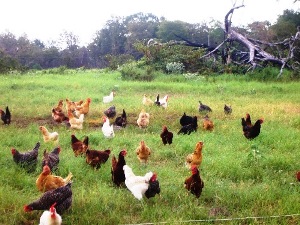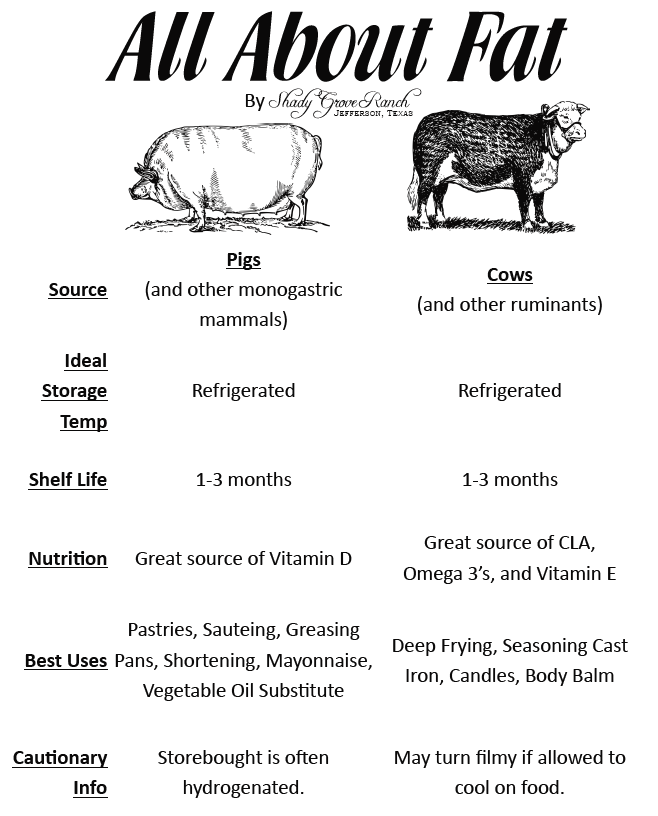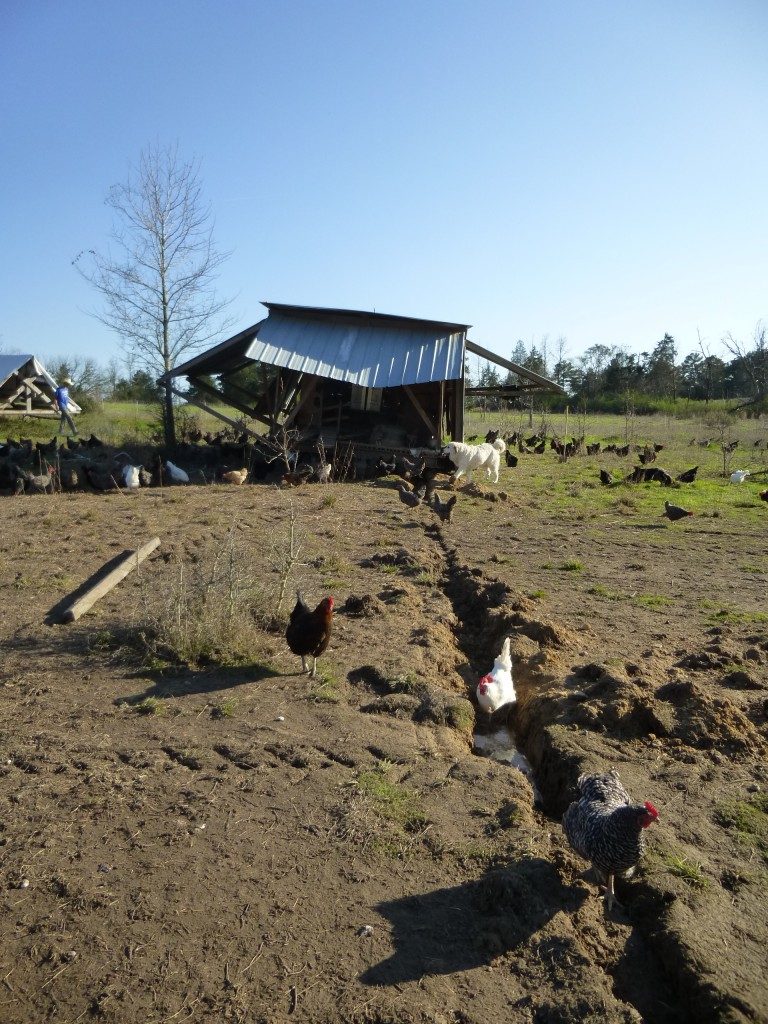| We often have people ask for guidance on how Matt made his recovery from ulcerative colitis. And I would say that, fairly often, they have received blood testing results that reveal various deficiencies that are likely contributing to their health issues. And so it makes sense that they seek out the supplement forms of whatever nutrients they’re lacking. Or does it? I remember when I worked for a local health food store, I’d see people literally fill a shopping cart half full of bottles of pills, and then head to the checkout, with not a single whole food item in their basket. Not one food. From a health food store. And this was back in the food dark ages, before Wal-mart carried their so-called grass-fed beef or much in the way of organic veggies, so I very much doubt they were getting good, clean food elsewhere. I found it both shocking and tragic. Maybe I was jumping to conclusions and they did eat lots of whole, naturally-raised foods; perhaps they had a farm like me, and only ventured to town to get those items they couldn’t produce. But I’m going to guess that was probably not the case. I think we have this wrong idea that if we’re deficient or suffering some ailment, it’s as simple as isolating that one thing we need and taking THAT. But what if it’s more complex than that? What if science hasn’t discovered all there is to know about the various compounds and chemicals in food? (Hint: it HASN’T.) I have an antique book fetish, especially antique farming books! I once found a book on poultry production that was published around 1921. It has a section that discusses vitamins, and it says something to the effect of, “We are aware of these new things called vitamins, and we know they’re important, but we’re not really sure of anything else about them.” It hasn’t even been 100 years since vitamins were widely accepted as useful. Ponder that for a moment! What if someone came up to you and told you this: “I have made this discovery of this great new thing—it can transform everything about you—your hair, your skin, your intestines, your reproductive health.” And then they told you that The Thing was to go home, scrub and peel some potatoes and carrots, and make yourself a pot of homemade chicken soup. Talk about anticlimactic, right? How could chicken soup solve my problems?? I thought you were going to tell me about some great new scientific discovery! But aren’t we all guilty of looking for something newer and shinier to solve our old problems? You can ask Matt about my “meal planning” history, and he’ll laugh out loud. I’m always coming up with new ideas to solve my age-old problem of not being disciplined enough to write out a meal plan and knuckle down and DO IT. When it comes to finding a farm, researching their practices, going to the farm stand, buying what’s in stock, then having to prep and cook and store and clean, and finally, after all that, the 3-year-old still complains that he doesn’t like it! It’s so much EASIER to just buy the bottle of pills, isn’t it? That saves you from eating weird foods you don’t feel like eating just because they “have vitamins.” Hey, if we could all subsist on chocolate, popcorn, ginger ale, and multivitamins, why not? But I think there’s more to the story… I did a fun little podcast many years ago with a dietitian friend of mine, and she told the story of the time she was taking a course on children’s nutrition. Scientists had isolated a compound in blueberries that promotes immunity. So they took the compound and tried to spray it onto breakfast cereals (that’s where most of the “fortified” nutrients come from, you know), but they couldn’t produce the same results from the isolated additive as from the actual blueberries. She wanted to shout out in the class, “Just eat the blueberries!” EXACTLY. Maybe it’s not the random chemicals we’ve identified in foods. Maybe it’s the foods themselves. What if instead of taking iron, you ate iron-rich foods like liver, which also contain things like zinc and manganese and various enzymes and fatty acids that all help that iron molecule make it to where it belongs in your body? I’m NOT saying that supplements aren’t useful or necessary. We often get into predicaments where our bodies simply cannot get enough of “the things” they need from food alone. Some supplements, like probiotics and fermented cod liver oil, help us get more out of our food over the long haul, and are really more like foods themselves than just isolated chemical concoctions. Even if we find that we need to supplement a mineral here or there, doesn’t it makes sense to try to eat foods that contain “the thing” naturally, in order to augment our supplementation? In other words, I don’t think it works to continue eating processed junk, and simply take a multivitamin. Supplements do NOT cover a multitude of bad foods. 😉 Sometimes getting healthy is really as simple and non-glamorous as going to bed on time, moving your body every day, and eating normal, real food made at home from good ingredients (like chicken soup!). I’m afraid that, like with most things worth having, there’s no silver pill. Thank goodness the solution tastes way better than any supplement! 🙂 |
Category Archives: Real Food
What’s the Difference Between Lard and Tallow?
What’s the Difference Between Lard and Tallow?
A very common question I get about our products is, What is the difference between lard and tallow?
They are both types of rendered fat, and both have been around for a VERY long time. I’ve observed that very old words often have multiple meanings, or maybe the current meaning has shifted slightly away from the original meaning. All that to say, not everyone who reads this will agree with my explanations of these ancient foods. However, I want to try to shed some light on what I know about the subject.
The basic difference is what animal these fats come from. Lard is Pork Fat. Tallow is Beef Fat. (Tallow may also include lamb or other ruminant fat, and even if that’s true, the following would still be generally true.)
A fun fact for you is that rendered Chicken Fat is called Schmaltz. And yes, it’s a thing. You see it in the pan after you’ve roasted a nice plump chicken.
Lard, Tallow, and Schmaltz are all rendered fats.
What does “rendered” mean?
Every healthy mammal’s body contains fat in two areas: under the skin, and around the kidneys. What that fat is NOT is free liquid oil, floating around in the body. Nope. The raw fat from a cow or pig or chicken must be removed from its surrounding connective tissue before it can be useful as a cooking oil. That’s a very simple process (UNLIKE the extraction of seed oils from tiny, non-oily, non-mammalian seeds and grains like cottonseed or corn). All you have to do is warm the connective tissue up gently, and out melts the liquid fat. The fibrous (for lack of a better word) tissue left behind is “crackling,” and makes a very hearty snack when you crisp it up in a skillet.
This process is called Rendering, and it ends with the two byproducts: Crackling and liquid Rendered ___ (Lard, Tallow, Schmaltz). Crackling is a bonus, but the liquid oil is what we’re really after. You don’t really need to include the “rendered” part because the names of those products imply that the extraction has already taken place, but it can eliminate ambiguity that can come with those super-old words. In fact, I don’t even know what raw pig fat is called. Pig fat, I guess! Ha. Raw beef fat is called suet, but even then… some people use the word suet when they mean rendered tallow and vice-versa.
What is the functional difference between Lard and Tallow?
Source
Lard can actually come from two different places on the pig. Pigs are fat factories, after all! Depending on how the pigs are raised and what breed they are, much of the fat can be found under the skin, and would be called Back Fat. Back fat produces a lard that is much lower in saturated fat, and I hypothesize that it’s this area that would tend to be richer in Vitamin D if the pigs are raised on pasture, since the skin is where vitamin D is manufactured. The other area pigs store fat is around the kidneys (like all mammals), and kidney fat tends to be higher in saturated fat, and therefore will be stiffer and harder at a given temperature. Either one from a pig tends to be much more unsaturated than Tallow, meaning it is softer and more pliable.
Beef fat principally comes from the kidney area. A very fat cow will have fat under the skin, but it’s not thick like on a pig, therefore it will tend to be more difficult to harvest. Plus, since beef hangs much longer than pork after slaughter, the skin fat is usually left in place to protect the underlying meat from oxygen and moisture loss.
Taste
Lard is a delightful replacement for Crisco (or should I say, Crisco attempted to replace lard!). Lard is the best choice for pastry and other baked goods. Rendered correctly, it will have very neutral flavor. Generally speaking, pork back fat will tend to taste a little “porkier” than pork kidney or “leaf” fat, but done right, either one is very mild in flavor. I had a chef once tell me that his favorite way to make chocolate chip cooks is using lard!
In my opinion, beef fat has quite a “beefy” flavor, even when rendered quickly and carefully. If you are just getting started into incorporating animal fats, and maybe have that lingering fat phobia that I did when I first started, I might suggest starting with lard and working your way up to Tallow Level. Who knew real food could be so much like a video game? Haha. But you can use that natural flavor to your advantage. Tallow is an excellent frying oil, and it makes the World’s Most Delicious French Fries. Did you know that McDonald’s used to fry in tallow when they first opened their restaurant chain back in the 1940’s? But the cholesterol scare lobbyists pushed for them to eliminate animal fats from their frying oils, so now to achieve the same authentic flavor, they have to add “essence of beef.” Sad, huh?
Texture
In its solid state, tallow is similar in texture to cold butter. It is crumbly and hard when cool and therefore will not make a great choice for pastries, since it is not very pliable. Because tallow is highly saturated, it solidifies easily at room temperature and can leave a filmy feeling in your mouth after eating if your food has cooled down too much.
Lard, however, tends to stay liquid after being melted, and is a great choice for sautéing vegetables or browning meat. It is quite soft at room temperature and is very much like Crisco in possible uses.
Nutrition
Remember, lard comes from pigs, and pigs are akin to little Vitamin D factories when they are raised outdoors. Lard is the best natural source of vitamin D on earth, only second to cod liver oil. When piggies are out on pasture, soaking up the sun all day, their hormones help them create vitamin D, which is stored in their fat. Bacon is officially a health food. But only from pasture-raised pigs!
Commercial pigs, sadly, never see the light of day EVER. They are born inside and live inside until that very last day. CAFO (confined animal feeding operation) pork is among the saddest commercial “foods” that there is, because confining these animals under such stressful conditions does a great disservice to their piggy personalities, and it also does a great disservice to pork lovers everywhere because they are missing out on this wonderful, natural source of vitamin D. You can’t get much natural vitamin D if you never see the sun.
Additionally, many commercial pig operations add Ractopamine to the feed, which tends to unnaturally force the pig’s body to reduce stored fat and increase muscle, so that the final cuts will have more profitable muscle and less fat. I think it’s rather tragic considering all the benefits of pork fat, not to mention the delightful taste of Real Pork.
Tallow’s benefits include all those associated with grass-fed beef. When you hear someone spout off the list of great things about grass-fed beef, guess what? MOST of those benefits are ONLY found in the fat. Higher Vitamin E, Conjugated Linoleic Acid (CLA), and Omega-3 fatty acids. And tallow, of course, being pure fat, is chock-full of all of them! On the other side of that coin, however, is that commercially-raised cattle fed corn and soy, do not have these beneficial fatty acids in their fats. Once again, it’s all about what those animals are eating and how they are raised that ultimately determines the benefits the human consumer is able to obtain.
Here’s a fun little chart summarizing the main differences between Lard and Tallow. Find out how to get some here!
Fats are a delightful way to stretch a meal and increase its nutrient-density. I hope this article has been helpful and informative! Thanks for reading.
–Jerica
When Natural Becomes Unnatural
Our journey started 14 years ago, and in that short time, pasture-raised foods went from unheard of to wildly popular to what I might describe as “enhanced.” What I mean is that it wasn’t enough to just have a return to bacon or milk or bone broth. Now things like turkey bacon or ultra-filtered milk or bone-broth protein powder are in vogue.
Any turkey farmer could tell you—there’s not a muscle in that bird that resembles bacon. Not even close. Birds don’t make bacon. And milk doesn’t come out of the cow at half the fat and sugar and double the protein. What about protein powder? What is that stuff, really? Ground freeze-dried steak? It’s generally my philosophy that if I couldn’t figure out how to make it in my own kitchen, it’s probably not a good idea to be eating it… Just because some scientist says that what you really need is more protein, doesn’t mean you manipulate nature to get it. Now I realize that may step on some toes, and I cannot claim our diet is totally sourced out of our backyard. Nope! It’s definitely a balance, and I’m still working on improving things as I master various components of achieving a healthier lifestyle. But I say this in order to encourage you to really think through each ingredient you use, especially those more expensive ones that you’re using expressly to be healthier, and make sure it makes sense.
After all, everything is “natural” when it comes down to it. I mean, humans source all our ingredients on Earth. Even if ingredients came from Mars, there’s really no such thing as not from the “natural” world. What we really mean by natural, when it comes to food, is that it’s not synthesized or artificial.
So when does Natural become Unnatural?
One practically-unknown practice is egg yolk color enhancement. There is a product out there that is sold in much the same way as house paint. The farmer can get a little book of “chips,” and decide precisely which shade of yellow-orange he wants his eggs to be. He then calculates the amount of the powder he needs to add to the feed. Voila! Beautiful, appealing, golden yolks.

I think we could all agree that THAT is unnatural.
But what about “natural” methods of color enhancement? Some enhancement could be considered incidental and unintentional. For example, feeding yellow corn instead of white corn will impart an orange hue to the yolks… naturally? Sure. The chickens need to eat some carbohydrates. Corn is actually a pretty decent choice (assuming it’s not genetically modified!). If it happens to be yellow, the chicken can’t help but pick up those beta carotenes. It’s how she was designed.
But what about non-nutritive natural products that are added *just* to enhance color. That’s the only reason they’re there. Is that “natural?” A common practice is calendula petals. AKA Marigolds. Well, flowers are surely natural! The yellow in the flower ends up as the yellow in the yolk. Is it harmful? Maybe not. But is it NATURAL?

We have to ask … why? Why do we need to add that? Consumers are expecting a nice golden hue, and you even hear it said that the darker the yolk, the healthier the hen.
But isn’t that just a little like having an athlete on steroids? He couldn’t really do that without the crutch. It’s not natural strength. It’s artificial. Even if it’s a “natural” substance making things so.
So what about Shady Grove Ranch? Well, if you’ve been buying eggs from us for a while, you might remember that time a few years ago that it rained cats and dogs and maybe some elephants and hippos, too, and our egg-mobile got stuck on the downhill side of a levee that was bursting at the seams with overflowing pond water. The egg-mobile got stuck deep in mud, and the tractor with it. I think there may even have been a second tractor involved!
We finally had to just wait until the ground dried up to move the egg house. So the chickens ran out of live vegetation for a time. And the yolks told the story. They got quite pale that season. We tried to explain to our customers. We were and still are rather small, so we were able to speak directly with our customers about the issue, and they were generally glad to continue buying in spite of the lighter yellow they were seeing.
Where does that hue really come from, anyway? It’s supposed to come from the green pigment in live grasses! Anyone familiar with real pasture-raised eggs knows the richness of color they can see in springtime, but also the variation in color that is associated with natural husbandry.
That’s the story this photo tells. Here are 3 eggs, collected on the same day, from our two active flocks of laying hens.
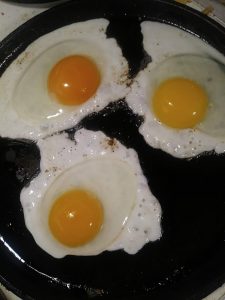
That’s quite a difference in color, if you ask me! Maybe one of those chickens deserves a promotion for her go-get-em attitude. But I’d take a real pasture-raised egg, light yellow or otherwise, over an artificially-colored commercial egg any day.
Eggs are a little tight this season, but production is rising daily with the longer days. I’ve just replenished the online store inventory, and we’ll be here at the ranch all week, including Saturday, if you’d like to make a trip to the farm to stock up. We’ve got lots of other good stuff in stock, too!
Thanks for reading!
Jerica
How to Keep from Going Gray
Not gray hair, mind you. I’m not sure there’s a cure for that, especially when you run a crazy ranch like we do! 😉 I’m talking about something else…
As I cooked breakfast a couple of days ago, I noticed on the mostly-empty package of pork breakfast sausage I had thawed a few days prior, that the edges of the meat had gone gray. Some people might call it brownish. It was pork, so it was a very light pink to begin with, and that, mixed with a faint brown, really looked grayish to me more than anything. It was certainly not the pinkish color one normally encounters when first opening a pack of our sausage. I knew it wasn’t spoiled. It was only days old, I had thawed it in the fridge, and it smelled great—like clean, sagey pork sausage!
Having done pretty extensive chemistry studies in college, I knew it had only grayed up because of its exposure to air, and this speculation was confirmed by noticing that the gray was only at the open edge of the package, not within the bulk of the meat, or along the sealed edges of the clear packaging. This is called Oxidation.
You’ve seen oxidation plenty of times. You know how if you make a bowl of guacamole and put it in the fridge overnight, the top will turn a terrible icky brown color, but underneath it will still be a beautiful yellow-green?
That’s oxidation.
It’s a natural process we are all fighting (most of the time—sometimes oxidation is good!).
Oxidation is why we’re aging. It’s what makes our cars rust. It’s what makes our guacamole turn brown.
And it makes our meat turn gray-brown in the fridge, unless…
…unless we do something to stop it! But WHAT?
I know you’re super busy, and this is a BIG can of worms kind of topic, so I’m just going to boil it down for you.
Meat naturally oxidizes when exposed to air.
It goes from red (or pink) to brownish-gray. The meat industry has figured out that customers don’t want to buy brownish-gray meat, but they also don’t like buying frozen meat (which is WAY fresher than “fresh” meat), so they have a couple of practices in place to prolong the shelf life of “fresh” meat.
My little breakfast sausage experience this week reminded me that you might not know about some of these practices, and you might find it surprising if your perfectly-safe raw sausage or hamburger turns gray-brown before you use it all up.
Industry Practices to Keep Meat from Going Gray
1. Add preservatives.
Sodium nitrate is the most familiar example of color-preserving-agent, and it is used to make bacon a really pretty pink color, in spite of the fact that it’s smoked and “cured” (aged). If you were to smoke plain ol’ pork belly, it would turn gray-brown–like the color of a patty of cooked sausage or a cooked pork chop. Now it is true that some vegetables are high in natural nitrites, and so if you add something like celery juice to your bacon brine, it can accomplish the same thing, but using a naturally-produced ingredient rather than a man-made product. Voila. Pink (naturally) bacon!
Nitrate is probably on the less-scary end as far as artificial additives go, but things like BHT raise my eyebrows a little higher. You don’t see BHT in plain meat products very often, probably because added preservatives always have to be labeled (as far as I know). And adding stuff like BHT to hamburger might not fly among savvy shoppers, but those three little letters might slip by pretty easily if they’re surrounded by other more benign ingredients like sausage seasonings.
2. Feed arsenic to the animals.
Blech. I know. But it’s true. Commercial poultry companies have found that by feeding small amounts of organic (carbon-based) arsenic, the meat will turn out pinker and more appealing in appearance. No, the arsenic doesn’t all get pooped out like they originally thought. And no, they still haven’t officially banned it in the US. And yes, they feed the arsenic-laden chicken poop to cattle, even the “organic” ones. Not kidding. It’s scary out there, folks.
3. Douse the meat in carbon monoxide.
By now, you probably think I’m making this stuff up to scare you. I only wish it was so! They poison the meat?? Yep, pretty much. And the reason it works is the same mechanism by which it would poison your body—myoglobin (the stuff that makes meat look red) has a strong affinity for CO (carbon monoxide), much more so than for regular oxygen, so it grabs onto the CO molecules and hangs on for dear… death? Meat that has “bonded” with CO can’t oxidize in the normal way, so it stays bright red for a longer period of time.
The benefit in the meat industry, of course, is that the meat can remain unfrozen without turning colors for longer periods of time… even if it has already spoiled! The literature is scarce when it comes to safety of this practice, and of course no label is required because it’s not considered an “additive,” but rather a “processing step,” even though some package types may still contain actual CO gas. Consuming the meat has been declared GRAS (Generally Recognized As Safe) status, even though CO exposure has been linked with autism, and consuming meat exposed to CO does not have undetectable results.
Let’s get this straight. Meat packers are adding poison to food without labeling it because it’s poorly-researched effects are probably negligible. And they’re doing this, not to enhance safety or quality, but only to accomplish the appearance of those things by literally tricking the customer. And they’re doing it simply because people think it’s weird to buy frozen meat, but apparently they’re ok with not being aware that they’re buying meat that may have been sitting out for upwards of 2 or 3 weeks before purchase? Is this the kind of food production American consumers should be supporting?
It’s enough to give you gray hairs, isn’t it?
This is why it’s important to choose food producers that have your health in mind. Not just your dollars.
So how do we keep from going gray without poisons?
Well… it’s a pretty simple solution, really. We at Shady Grove Ranch keep the meat frozen. Meat products have a delightfully long “shelf” life in the freezer. And then after it thaws, well. It might just turn a little grayish-brown (ground meat in particular, since it has more surface area exposed to oxygen). If you practice safe thawing techniques, keep your fridge nice and cold, and wrap stuff up tightly if you don’t use it all right away, it should stay nice and pink until you cook it. It’s not going to hurt you if it turns a little grayish-brown due to oxidation. But you won’t have that problem because it’s so yummy, how can you wait any longer to eat it? 😉
Thanks for reading this far. We appreciate you investing in knowledge about how your food is produced!
Jerica
PS–In case you care to do more reading about this complex topic… And in case you want to order some meat that does not have arsenic, sodium nitrate, or carbon monoxide in it. 🙂
Becoming an Eggspert Isn’t Easy
This Egg-ing Thing is Tough!
We’ve been raising laying chickens for going on 9 years now, and we find that the more we learn, the more there is to learn!
Early Lessons in Raising Eggs on Pasture
For example, one of the early lessons we learned is if you suddenly switch feeds on your hens, their bodies panic and they quit laying eggs and start making new feathers (aka molting) in case there’s going to be an extended food shortage.
Or if you buy baby hens (we call them pullets) with springtime as the target date for starting to lay, you’ll have eggs up to your ears, especially if it’s a mild spring. The thing is… so does everyone else—you can hardly GIVE an egg away! But by August when the weather turns really hot, there will be nothing!
So, learning from that experience one year, the next year you buy a batch of hens, aiming to have at peak production by July. Well, forget having eggs at Thanksgiving from those chickens! And they may or may not turn back on until springtime, so a backup plan is pretty necessary.
But it takes almost 6 months to get a chicken to laying age, and even the first few weeks of that, the eggs are teeeeny tiny as the hen’s system gears up to produce real, normal-size eggs.
Yep. In our extreme climate here in Texas, egg production is really unpredictable. No one can say what the weather will be up to 6 months down the road. Whether it will be a harsh, brutal winter or a mild one. A scorching, dry summer, or a lush, cool one. And for hens raised on pasture, it makes a big difference. And sometimes, here in Texas, those weather patterns come closer together than a body can reckon with!

She’s not getting older… she’s getting bigger!
Another interesting phenomenon is egg size as it relates to hen age. In general, during a hen’s life cycle, her eggs will gradually get larger as she gets older and puts on weight (it’s actually because her ovary—she only has one active one—grows larger as she ages). But there are seasonal effects, too. In winter, the hens tend to eat more feed to produce more body heat, and so their eggs will be larger. In the dead of summer, they drink a lot more water but eat less feed, so they will still lay large eggs, but fewer of them. In spring and fall, when there’s lots of grass and bugs to nibble, the eggs will tend to be smaller. Take a snapshot at any given time of year and of any given batch of hens, and you’ll see a wide variety in distribution of egg size.
Crazy, huh? Even crazier when you’re a direct-to-consumer farm and all the eggs you’ve got to sell are the ones your chickens are laying. To say it another way, if your hens are only laying very small or very large eggs… that’s all there is!
How does this all compare to a commercial egg operation?
A typical commercial egg farm might have around 7 million hens. They could collect 5,000,000 eggs or more PER DAY during the peak season. To put this into perspective… it would take us 57 years to produce as many eggs as they can produce at just one farm in one day!
There’s nothing inherently wrong with being big, of course, but to do really-pasture-raised at that scale would be pretty doggone difficult. Theoretically it *could* be done. But most of us who are really-pasture-raising our hens are MUCH smaller operations.
It’s not that the giant egg farms don’t have to deal with these seasonal issues, although keeping the hens indoors can help keep the temperature and lighting much more uniform throughout the year (for better or worse…). I’m sure their hens still produce pullet-size eggs for a time, and some eggs are weird shapes, and some eggs are double-yolker jumbos and some have stains on the shells… But supermarket-shopping consumers never see these anomalies and extremes of production, so it seems as though they must never occur.
The reality is… when you’re THAT BIG, you have access to a wider variety of markets. If your eggs are too small or too big, you can sell to the liquid egg/dried egg/processed food market. If your eggs are not Grade A (like if the shells are misshapen or have stains), you can sell to institutions like cafeterias, delis, restaurants, food distributors, etc. If your eggs have cracks, there are special markets for salvaging those. Those of us who sell direct really can only sell premium eggs in common sizes. It’s really hard to sell pullet-size and jumbo-size to the average customer.
If you’re a small fry like us, but bigger than just a backyard farm, you produce too many “weird” eggs to eat yourself, especially during those transition phases, which are amplified when the hens are having to deal with real weather patterns. So you have to come up with strategies to try to balance things. But sometimes nature is unpredictable, and there are LOTS of factors that affect outcomes.
Pickled Eggs!
We’re in that sort of a pickle right now, as you can tell from our online farm store. The older batch of hens is going through a molt, so though they’d be laying larger eggs right now, they’re taking a break for the summer.
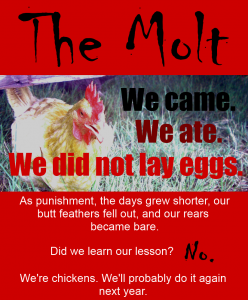
The younger recruits are stuck in pullet/small phase! So we have lots of eggs… but they’re all tiny!
Nine years of egg production, and we still feel like rookies. Ha! Just goes to show you that farming is like parenting. You don’t know how to do it until after it’s over. 😛
What’s an SGR Fan to do?
Y’all hang in there with us. And buy a few extra eggs to make up for the smallness. The small ones are big on taste! 🙂
How to substitute small eggs in recipes
Small eggs are ¾ the size of larges. The easy way to say that is that for every 3 large eggs called for, use 4 smalls. Or you can just multiply the number of larges times 1.5, and that’s the number of smalls you need. Pullet eggs or “peewees” are 5/8 the size of larges. They’re just a smidge bigger than half a large egg. Most recipes are not so finicky that you can’t just pretend that 2 pullet eggs equal 1 large egg. If you get into some huge volume recipe like a soufflé or custard, I’d suggest using the 5/8 (5 larges = 8 pullets) conversion. But if you’re making soufflés and custards… you probably don’t need me to explain this. 😉
3 Simple Ways to Eat Healthier in the New Year
Three Simple Ways to Eat Healthier in the New Year
Now’s the time, right? You’re sick of sweets and ready and motivated to eat better. Don’t get overwhelmed by the elaborate meal plans and complicated recipes one sees “out there” these days. Don’t go crazy trashing everything in your pantry and fridge and leaving the family hungry and tempted to grab a pizza on the way home.
Instead, gently move toward a better way of eating healthy foods regularly. And if you’re anything like me, if you’re going to do something regularly, it has to be pretty simple.
Here are 3 really simple (and delicious!) ways to eat healthier in 2018:
- Eat real food for breakfast.
- Make bone broth.
- Use your crockpot wisely.
Eat Real Food for Breakfast
I wrote last month about a perfect breakfast food: Smoked Ham Steak. I called it this not because there’s nothing “healthier” out there that a person could eat for breakfast, but because sometimes something really tasty but still really good for you, all the while being really easy to incorporate in a fast-paced lifestyle… those criteria are what make a good food great. If “healthy food” requires so much work, planning, and supplemental ingredients that we end up saving it for when we “have time”… that’s just not sustainable, and we’re going to fall right back into the processed-food rut. Why? Because it’s easier.
But I’m convinced that homemade food doesn’t have to be difficult. I DO think it’s best to approach it with baby-steps, and that’s why I’m writing this article.
So now that the holidays are behind us and the last of the Christmas cookies, candies, and pie are eaten up, we’re all thinking about how much we want to start our new year out making good food choices and instituting new, healthier routines. May I just remind you to be sure that they are doable routines?
Here’s a very doable breakfast item that I would encourage you to incorporate at least once a week. It’s done in less than 10 minutes with no extra ingredients required. And it’s on sale this month, just in time for our January deliveries! Add Ham Steak to the menu!
Make Bone Broth
I can’t tell you how many food bloggers and recipe sites I’ve come across that just make broth too complicated, and they intimidate perfectly capable people out of making this nourishing and delicious food.
There is no “right way” to do broth. But a definite wrong way to do it is not to do it at all! Now you have no reason not too—we’ve got chicken soup bones back in stock, and beef soup bones are on sale for half price this month. Read my Broth Tutorial to learn how very simple and no-nonsense broth-making actually is.
So what do you do with this broth? Well, one really easy way to use it during cold weather, is to make soup! The simplest soup I know of is French Onion Soup. Are you ready for the recipe? It’s a 3-liner: Thinly slice a large yellow onion, then sauté it in a saucepan over medium heat in a few tablespoons of butter or lard. Once the onions are soft and translucent (about 5 minutes), pour in 2-4 cups of prepared homemade beef broth. Add salt and pepper to taste. That’s it! You will not believe how delicious and simple this is. Go for it!
Use Your Crock-pot Wisely
What do I mean by wisely? Well, for one, you’ll need to thaw the meat the night before you set this up, so add that to your evening routine. That’s probably the hardest part of this healthy-eating strategy! But I’ve even been known to cook a partially frozen roast if I forget to take it out the day before. The texture will be nicer if the meat can be allowed to do a slow thaw, but in a pinch, frozen works, too. For mostly-frozen roasts, just plan for some extra cook time, and add a touch of liquid at the beginning of cooking.
But I think a bigger issue than remembering-to-thaw-the-meat is when people assume that recipes have to be super-elaborate to be tasty. Again, if a mile-long list of ingredients is holding you back from real home cooking, you’re doing something wrong. You don’t need exotic spices to make a good meal. When you use good meats, their flavor is brought out by a good sea salt and appropriate cooking time. That’s all you really need.
My favorite way to make a crockpot roast is to take either a beef chuck roast or a pork shoulder roast and place it at the bottom of the crock. Sprinkle it with salt, then add whatever veggies you like: potatoes, carrots, celery, onions, garlic. You can even mix it up and use rutabaga, turnips, cabbage, peppers, or sauerkraut! If you prefer a soupier roast, add a little homemade broth or water. You could even add beer or wine! I do not usually add any liquid, as the roast will produce plenty of liquid on its own. Fit the lid on snugly, then turn it on low and cook for 6-8 hours.
That’s it!
Don’t add cans of cola or cream-of-chemical soup. You don’t need Italian seasoning mix or meat tenderizer powder (MSG, anyone?). Just let the meat be delicious because of the clean way it was raised.
Recap!
- Eat real food for breakfast.
- Make bone broth.
- Use your crockpot wisely.
I hope these 3 strategies will help you include more real food in the coming year. Happy, Healthy Eating!
–Jerica
The Perfect Breakfast Food
The Perfect Breakfast Food
What’s the perfect breakfast food, according to your farmers?
Is it a smoothie full of hidden organ meats, freeze-dried berries from Mt. Everest, and a dozen types of organic greens? (My crunchy self is giggling over this one!)
Is it a powdered mix that serves itself up all hot and caffeinated as a one-pot wonder?
Is it the sweetly encrusted donut that is the only thing you can face at that hour of the morning before your coffee has kicked in? Hey, some breakfast is better than none, right?
Is it a 16-course gourmet meal complete with locally-grown edible superfood flowers, homemade bread with freshly-churned butter, biscuits, pancakes, a tall glass of fresh raw milk, and a plate full of farm-raised eggs, bacon, sausage, and ham?
Well… My husband would probably nod his head vigorously to this last option, and I’ll give you a hint that it’s the closest thing to what I envision as the perfect breakfast food for the fast-paced family on the go. But not the whole 9-yards. Just that last little 3-letter word.
Ham.
But not just any ham.
Real, smoked, pasture-raised, chemical-free, deliciously natural ham. Just sweet and salty enough to be nice and hammy but not overwhelming in any particular direction, and of course plenty smoky. The best part is that it’s sliced thin enough to thaw quickly and cook even more quickly with little effort (choices include ½” or ¾” thick).
Just warm your skillet, maybe toss a tablespoon of butter or lard on unless you’re using cast iron, and lay the ham steak gently down. Warm over medium heat until steaming, then flip and repeat, a few minutes per side. Voila! Done. Breakfast. The perfect breakfast.
What’s so perfect about pasture-raised ham?
Well, it’s sweet enough to face in the wee morning hours. Lightly salted so you don’t have to guess on seasoning. Nice and smoky. And our favorite feature: Ready to heat and eat.
And even if that’s all you eat for breakfast, you’re probably going to have one happy tummy all the way to lunch, not to mention you hardly had to do anything to prepare breakfast, and there might be enough left over for tomorrow or to carry with you for lunch! But you can get fancy, too, and cook some eggs or biscuits or hashbrowns or whatever you like, and have a delicious country-style farmer breakfast. Toss the bone into a freezer bag and save it to add to your stockpot next time you make broth to get even more value from this humble but lovely little cut.
So why am I telling you about ham steak when you’re busy stuffing Christmas stockings and trying to keep the baby from climbing the tree (at least that’s what happening at our house…)?
Because I have been pondering a renewed vision for helping folks get healthy by getting back in the kitchen, eating the right things, instead of feeling overwhelmed by daily decisions, the last of which ends up being what’s for breakfast/lunch/dinner. Maybe you just need a few good, but brainless, decisions to help you along your way. Enter pasture-raised ham for breakfast. Sure, doll it up with some scrambled eggs and fresh fruit if you like and are able. But the point is, even if all you eat for breakfast is a chunk of SGR ham, at least you are eating something filling and real. Ham steaks also make a pretty convenient quick-dinner idea, whether you do breakfast for dinner or chop it up for soup or eat it on a sandwich. It even goes great as a centerpiece meat alongside mashed potatoes or rice!
Ham is a cut we produce a lot of because, well, the rear-end of a piggy is pretty large! We finally found a smokehouse that will do an all-natural cure for us, so we are excited to officially introduce this delicious and convenient cut of pork! Check out all our delicious and clean smoked products here.
A brief update as we head into March…
We lost all the small birds!
You’re going to laugh. We ran out of little chickens! Other than a couple remaining 3-pounder birds, all we have is our December stock of whole birds, ranging from Really Big (4.5 lb) to Huge (5+ lb)–at least that’s what I’ve been able to find in the boxes so far. The good news is, though, that they are juicy as well as plump, and we’re going to run a sale when you buy 2 Big Birds through the end of March! Cook once… eat a bunch!
What’s with Big Bird?
Well, this is supposed to be a brief update. Basically, we have switched to a more forage-friendly breed of broiler (say that five times fast) called the Freedom Ranger. Compared to the conventional breed, Cornish Cross, the Rangers are more active and produce more dark meat–that’s good for our leg-loving customer base! Yum! But they’re huge…
Cook-at-Home Challenge Continues
Last month we started an initiative to equip readers to get back into the kitchen. We had about a dozen takers, and a few more besides that who planned to use the (free) recipes for the meats they already had in their home freezer. I LOVE helping folks get back into the kitchen more often, and away from processed foods.
My biggest piece of advice for Real Eating is this: Keep it simple. Don’t feel that you have to doctor everything up with a million exotic ingredients. If you eat a crockpot chicken twice a month that you created out of real, recognizable, non-chemical ingredients–that is major progress! Do it again this month with our easy Cook-at-Home Challenge, newly renovated to accommodate the Giant Chickens we have in stock… and accounting for that two-huge-chicken sale I mentioned. 🙂
I hope you’ll join in again, or for the first time, on the Cook-at-Home Challenge.
Where’s the beef??
You have probably noticed our rather sparse inventory of grass-fed beef. We’re right at the tail end of the winter grass season, waiting for the days to get longer and temps higher so the grass can really take off and finish out our beef.
This is where the rubber meets the road for true supporters of farm-to-fork. Sometimes there are just shortages of things, and when you improvise and use other cuts in place of traditional choices, or even redo your menu to include what’s “in season,” just for the sake of eating really-pasture-raised and supporting your farmer in the off-season, it helps us to keep producing the best meats and eggs in East Texas.
If you need help with substitution ideas, feel free to write me! I’m happy to try to help you get more real food into your kitchen!
We still have a good amount of hamburger and chuck roast, and even some filet, strip, and sirloin (on sale!), so enjoy it while it lasts! We expect to process beef around the end of March. Until then, shop what’s in stock!

Matt often asks for volunteers during evening egg collection, and Axl and Tevka are usually quick to join him. They are getting really good at not dropping the eggs!
Celebrate Local This Saturday in Longview!
We’re excited to partner with Jack’s Natural Foods in Longview, this Saturday only! We’ll have a tasting set up there from 10 to around 1, at this exciting Customer Appreciation Event. Come by and see me during the lunch hour, or at least drop by before they close at 5 to enjoy discounts and freebies. (Matt will be at the ranch building our farm store!) Bring a friend and let them taste REAL FOOD, too!

March Delivery Rounds
Bye, bye, February! Our March deliveries to area towns start next week. Go ahead and get your order in early! Sirloin Steak is still on sale, and we have a few more Smoked Carving Hams. See what’s in stock and what’s on sale. We’ll send area-specific reminders the Monday of each delivery week.
- Tyler: Thurs, March 2 at 11:30 on Dennis Dr.
- Shreveport: Sat, March 4 at 11 on Line Ave
- Longview: Thurs, March 9 at 10:30 behind Bowen Chiropractic
- Marshall: Thurs, March 9 at noon at Buchanan Feed
- Texarkana: Thurs, March 16 at 10:30 on Irongate Dr.
- Shreveport: Sat, March 18 at 11 on Line Ave.
- Jefferson: Pickup any time at the ranch by appointment!
If our local delivery options don’t work for you, we sell in LOTS of local stores. Check out our website under the Locations tab to see what’s where!
Thank YOU for supporting our farming adventures and choosing real food for your family. We couldn’t do this without you!
Why Meats?
I have some food for thought for you to ponder as we begin to answer some of the Big Questions that surround what we, the Cadmans, do and why we do it here at Shady Grove Ranch.
I’m going to do a series of brief articles that will hopefully build your foundation of understanding your food sources and also that encourage you to continue your commitment to supporting locally, naturally-raised foods.
I’ll keep it concise, and it won’t be research-paper-worthy (my researchy engineering inner self is protesting!), but I will provide a few sources to back up my claims. If you really care about the truth about food, I encourage you to dig deeper also.
So the first question is… when we started looking for healthier foods to heal Matt’s autoimmune gut disease (ulcerative colitis), why didn’t we start with vegetables?
Veggies were, after all, a little easier to come by in those days before the organic hype was reborn (this was back in 2006), and certainly they were cheaper than the “natural meats” we could find at that time. But when we ultimately took the plunge into farming, we focused primarily on animal products (beef, pork, milk, eggs, chicken, etc), in spite of the fact that they were more costly and difficult to begin with compared to vegetable production.
Now that’s not to say that we didn’t eat/buy any veggies (because we did a personal-size garden even before farming), and it’s not to say that it’s not important to choose organically-raised produce over conventional. And finally, that’s not to say that we’ll never have veggies as a farm product–in fact, we have grand plans to the contrary! (OK, enough with the disclaimers…)

But fresh, organic produce wasn’t the focus of our healing strategy. Why not?
One of the biggest influences on our eating choices was the work of Dr. Weston A. Price. Dr. Price traveled the globe during the beginning of globalization, but while there were still a significant number of people groups that continued to consume their ancestral diets. He studied groups like the Inuit, Celtic peoples, Polynesians, Aborigines, Masai, and indigenous Swiss.
Dr. Price looked primarily at dental health, fertility, and disease resistance as health indicators, and found that, though the peoples he studied ate quite a variety of foods, the common denominator was that the healthiest ones did not eat any refined westernized foods (like canned goods and processed sugars and grains), but they did eat at least some animal products from wild or sustainably-farmed sources, and they especially prized foods rich in fats and minerals, and fermented products.
Price-esque foods that Americans might be familiar with and have access to today would be things like bone broth, lacto-fermented vegetables, grass-fed butter and raw milk, pasture-raised eggs, grass-fed beef, pastured pork and chicken… Sound familiar? 🙂
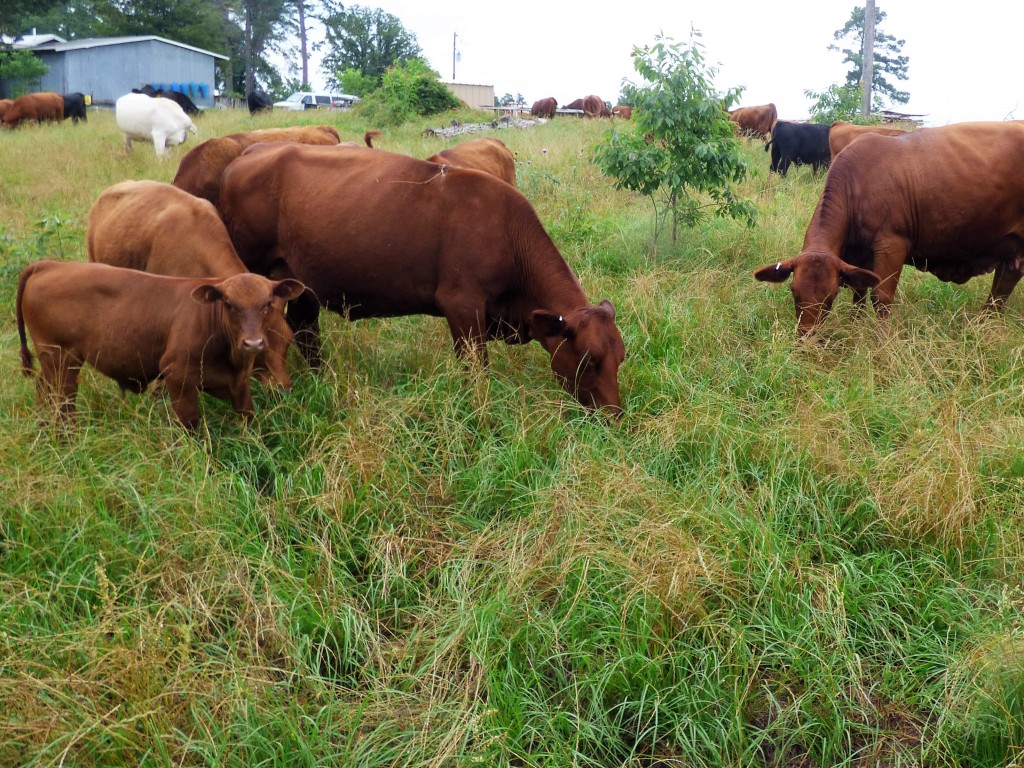
Meats, or more correctly, animal products (milk, eggs, broth, fats, as well as protein), are key to nourishing and healing a struggling body. Vegetables are lovely and certainly bring something significant to the table, but Matt never could have made his recovery on just those.

We began with things like whole pasture-raised chickens, homemade yogurt, lots of bone broth, and plenty of fat. And sure enough, Matt slowly got well and remains so as long as he sticks with his diet rich in animal fat, homemade broth, fermented foods, and minimal processed junk. I can’t tell you how revolutionary it was to be told that foods like butter and bacon were good for us, after a life of feeling guilt for eating those foods because of those “artery-clogging saturated fats.” That phrase was probably ingrained into you growing up, too!
Challenge: Try to find some real saturated fat at today’s typical grocery store. It’s only in a handful of foods! Even the meats are finely trimmed and practically devoid of fat. Clearly we have effectively eliminated saturated fat (be careful to distinguish that from hydrogenated vegetable fat) from the standard American diet, and yet our general health as a nation continues to deteriorate. Animal fat is not the problem. I believe it is our lack of nutrient-dense foods and the bewildering presence of additives, chemicals, preservatives, and drugs that are taking their toll on our health as a nation.
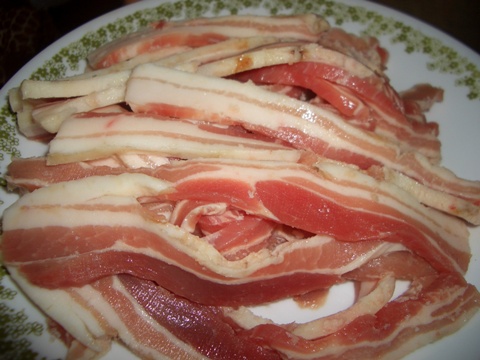
This is a glimpse at the beginning of our journey and the reason we started farming with animal foods instead of vegetables. Animal products, even conventional ones, are the most nutrient-dense and contain nutrients that cannot be found anywhere else, despite what a lot of vegetarian hype may suggest. I don’t write that to offend–I was once a vegetarian, too! But when I really began to study, I began to understand that we need animal foods. And our soils need animal pressure. But both need the right kinds.
Next time we’ll talk more about what the right kinds of animal products are and how to distinguish them from mainstream marketing ploys.
Thanks for reading! Hope to hear from you soon!
Is Organic Food Making Us Unhealthier?
Have you heard the term “Greenwashing?” Even if you haven’t, perhaps you’ve noticed the vast increase in availability of things at the supermarket that have pretty, healthy-looking little green labels. It’s so nice to have so many healthful options… or is it?
Not all that long ago in the East Texas/Shreveport area, real health foods were hard to find. I remember the days of driving from one farm in one town to get pastured, non-GMO-fed eggs, then to another farm in yet another town to get grass-fed beef, then still another farm in still another town to get raw milk. It was farm-driving madness! And to find grass-fed beef or pasture-raised eggs at the store? Ha! Fat chance!
But now you can find organic diapers, organic pop-tarts, organic banana puffs, even organic gummy bears and lollipops at just about any well-stocked supermarket. (And of course, there are quite a few organic and “grass-fed” meat options, now, too, but maybe those labels don’t mean exactly what we’ve been led to believe they mean…) But deep down, we all know that a lollipop, organic or not, is just a hunk of sugar. Don’t we?
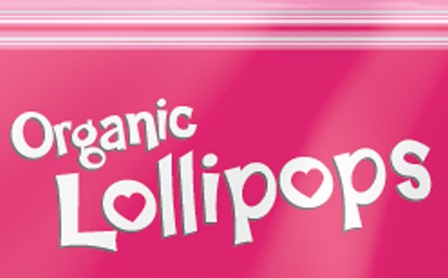
It seems to me that there’s a psychological component to eating. If something is presented as officially “healthy,” we sort of turn off our brains and chow down, forgetting the logical reasoning we normally step through before buying a product.
More than once, I have found myself victim of this. I was shopping at a new store and spotted a package of roasted peanuts that had a pretty little “With Sea Salt” label on the front. Autopilot kicked in and I didn’t even look at the label before putting it into my basket. My mind said, “Safe!” because that product had effectively been “green-washed,” and it wasn’t until I was 2/3 of the way through eating the jar that I finally happened to look at the label. It was shocking! Full of stuff that I always avoid, and I certainly would never have bought it if any of those other ingredients had been listed on the front of the package. How frustrating!
Has that ever happened to you? I bet it’s happened to even the most conscientious shopper. I learned my lesson, but how many different kinds of products do we each buy? Do we have to learn our lesson on every single one?
The prevalence of health claims and organic labels has effectively given shoppers full license to grab anything off the shelf and assume it is healthier than its conventionally-made counterpart. Be honest. How many times have you tossed that pack of cookies into your cart thinking it’s somehow healthier than the name-brand? But is it really? It’s still cookies! So maybe it was raised without synthetic pesticides or genetically-engineered organisms (GMOs). But that doesn’t equate with nutritious or beneficial.
This article isn’t intended to guilt you out or to encourage you to buy the cheaper conventional junk! Organic junk food is notoriously expensive! Haha. No, that’s not the point. Let’s work harder to keep our brains turned on while we’re shopping and keep the processed food, organic or not, to a minimum, and eat real, whole-food ingredients made into real meals with our own hands, even if they are simple, like scrambled eggs and homemade hash browns. Because that’s really what we need to truly improve our health, don’t you think?
